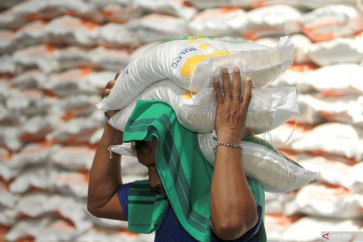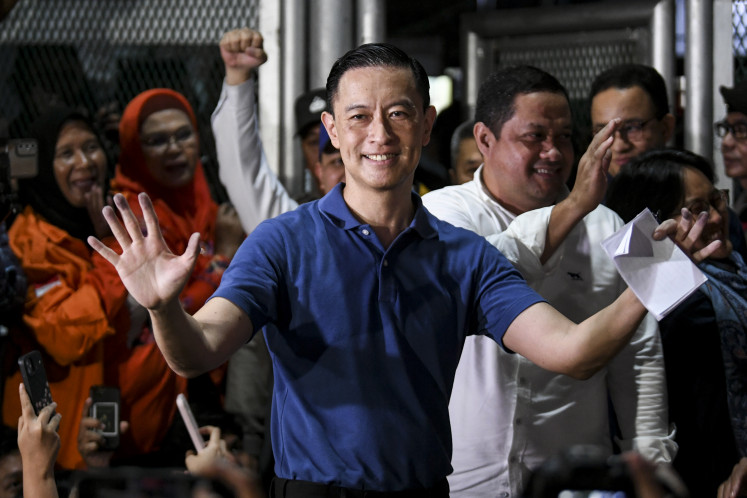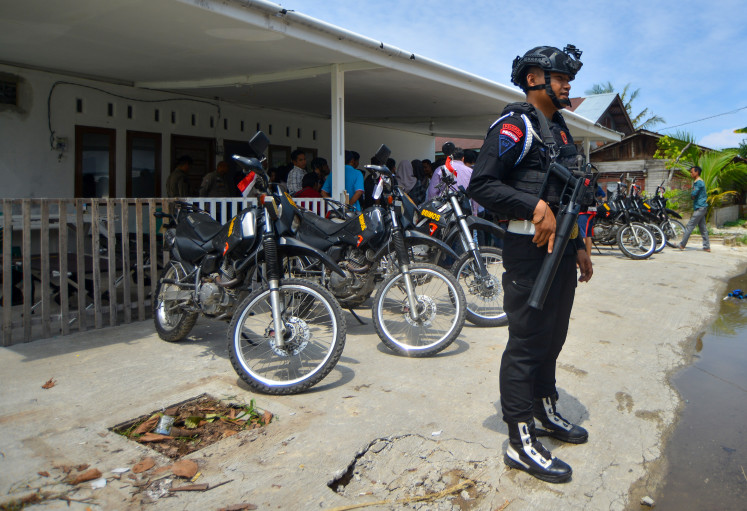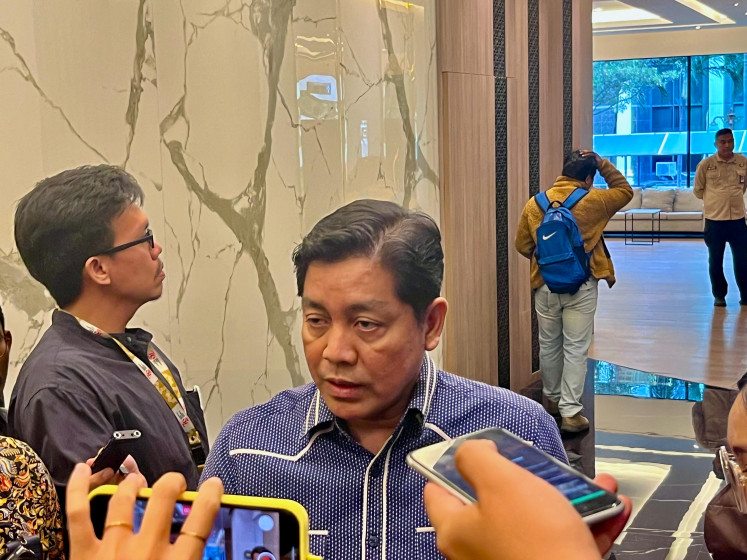Popular Reads
Top Results
Can't find what you're looking for?
View all search resultsPopular Reads
Top Results
Can't find what you're looking for?
View all search resultsThe doom & gloom of Jakarta’s monuments
Still standing: Workers install scaffolding to support the Welcome Statue at the Hotel Indonesia traffic circle during the construction of an MRT tunnel below the monument in 2016
Change text size
Gift Premium Articles
to Anyone
S
till standing: Workers install scaffolding to support the Welcome Statue at the Hotel Indonesia traffic circle during the construction of an MRT tunnel below the monument in 2016. (JP/Dhoni Setiawan)
The recently-demolished Getah Getih bamboo installation by Joko Avianto is just one of Jakarta’s numerous monuments marred by controversy and complications.
In 1964, President Sukarno had a discussion with then-Jakarta governor and painter Henk Ngantung about Jakarta’s skyline.
“I want Jakarta to have an artistic atmosphere. As Jakarta has to reflect a very high spirit of nationalism, it should be expressed through art,” said Sukarno. What he meant by art were monuments in the city.
Attempts were made by subsequent Jakarta governors to realize Sukarno’s idea. Former governor Sutiyoso, who served between 1997 and 2007, even proposed that statues of heroes be erected on roads bearing their names. The idea was swiftly rejected as it would turn Jakarta — where so many of its roads use such names — into “a city of mummies”.
Monuments have become an inseparable part and soul of the capital. But behind their attractive forms, the monuments have sad stories to tell.
The Heroes Monument in Menteng, Central Jakarta (JP/P.J.Leo)
Statue God Hermes
The story of the Heroes Monument reminds Jakartans of the statue of the Greek god Hermes in the courtyard of Fatahillah Square. The statue initially belonged to Dutchman Karl Wilhelm Stolz, who owned a store on Jl. Veteran during Dutch rule in Indonesia.
There have been illegal attempts to destroy and remove the statue — simply because it is naked. The statue originally stood on Harmoni Bridge, but the Jakarta administration moved it in 1999 and installed a duplicate statue at its former location.
Tragically, or perhaps absurdly, the lower part of the statue was wrapped in a batik sarong to look decent.
Heroes Statue
The Heroes Statue, better known as the Farmer Statue, near Gambir railway station has a sad story.
The work of Soviet Union artists Matvey Manizer and Ossip Manizer was once proposed to be demolished for allegedly depicting “The Fifth Force” — a political concept of the now-banned Indonesian Communist Party (PKI). In fact, it only conveys a mother’s blessing to her son.
“In Indonesia, even a statue is subject to slander!” renowned sculptor Nyoman Nuarta said.
Welcome Statue
The Welcome Statue at the Hotel Indonesia traffic circle was built to welcome the 1962 Asian Games in Jakarta.
The statue of a couple carrying a bouquet of flowers joyfully symbolizes a festival in friendship and peace, but since the collapse of the New Order regime in 1998, the statue has witnessed various mass demonstrations.
“Every time, hundreds and even thousands of people angrily shout and protest there. The name Selamat Datang [Welcome] has totally lost its meaning,” the monument’s creator Edhi Sunarso once said.
Forgotten: Rita Widagdo’s Waving Coconut Leaves sculpture was removed in 2017 from Kelapa Gading, North Jakarta, to make way for the construction of an overpass and the LRT. (Photo by Agus Dermawan T.)
Dynamism in Motion
No less saddening were the works of German-born artist Rita Widagdo. In 1974, she was commissioned to build a monument at the Senayan traffic circle. The result was an abstract stainless steel statue with flowing water, titled Dynamism in Motion.
The sculpture was well maintained in the beginning, but entering 1980 it became rusty and neglected — prompting people to call it the patung kaleng kerupuk (cracker container statue). It was removed in 1987 to make way for road widening. The Jakarta administration promised to relocate it to Rawamangun, East Jakarta, but the plan was never realized.
Another of Rita’s monuments that suffered a tragic fate was a three-piece sculpture titled Waving Coconut Leaves in Kelapa Gading, North Jakarta. Two years ago, the sculpture was torn down in preparation for the construction of an overpass and the LRT.
The Aerospace Monument in Pasar Minggu, South Jakarta (Antara/Andika Wahyu)
Aerospace Monument
The Aerospace Monument in Pasar Minggu features flying Hanoman of the Ramayana epic.
It was also Edhi Sunarso’s creation built with Sukarno’s own funds.
Before it was finished, the Sept. 30, 1965 attempted coup occurred, eventually leading to the fall of Sukarno. Nevertheless, Edhi continued the monument’s construction until it had consumed Rp 12 million (equals to US$48,000 at the time), with Rp 6 million being covered by Edhi’s studio.
Sukarno, who was isolated by Soeharto’s New Order regime, promised to repay it. The former president died in 1970 before the monument was completed.
“The most saddening moment was when the remains of Sukarno were passing beneath the Aerospace Monument. I happened to be working there. I couldn’t help shedding tears,” Edhi recalled.
The Irian Jaya Liberation Monument in Banteng Square, Central Jakarta (Antara/Muhammad Adimaja)
Irian Jaya Liberation monument
The Irian Jaya Liberation Statue in Banteng Square was inaugurated by then-president Sukarno on Aug. 18, 1963 — the same year that Irian Jaya became an integral part of the Republic of Indonesia.
The statue shows a bare-chested man screaming: “Merdeka! (Freedom!)” while raising his hands with newly broken chains.
It was sculpted by Edhi Sunarso in 1963 based on Henk Ngantung’s design with Sukarno’s creative intervention.
The statue stood elegantly amid a green and spacious environment for a decade until 1975 when the area was transformed into a bus terminal. The terminal was relocated in the 1990s, and the area abruptly became deserted — the statue looked lonely, seemingly shouting without company.
Banteng Square was crowded only in certain months when it hosted botanical fairs. In those moments, the square was often filled with political campaign banners.
The monument once again emerged valiantly in 2016 when then-governor Basuki “Ahok” Tjahaja Purnama launched a major renovation of the area. Banteng Square public park was inaugurated in 2018.
Former president Sukarno’s sketch of the Irian Jaya Liberation Statue (Agus Dermawan T.)
![Still standing: Workers install scaffolding to support the Welcome Statue at the Hotel Indonesia traffic circle during the construction of an MRT tunnel below the monument in 2016. (JP/Dhoni Setiawan)" width="780" height="445" border="0">Still standing: Workers install scaffolding to support the Welcome Statue at the Hotel Indonesia traffic circle during the construction of an MRT tunnel below the monument in 2016. (JP/Dhoni Setiawan)</p><p><em>The recently-demolished Getah Getih bamboo installation by Joko Avianto is just one of Jakarta’s numerous monuments marred by controversy and complications.</em></p><p>In 1964, President Sukarno had a discussion with then-Jakarta governor and painter Henk Ngantung about Jakarta’s skyline.</p><p>“I want Jakarta to have an artistic atmosphere. As Jakarta has to reflect a very high spirit of nationalism, it should be expressed through art,” said Sukarno. What he meant by art were monuments in the city.</p><p>Attempts were made by subsequent Jakarta governors to realize Sukarno’s idea. Former governor Sutiyoso, who served between 1997 and 2007, even proposed that statues of heroes be erected on roads bearing their names. The idea was swiftly rejected as it would turn Jakarta — where so many of its roads use such names — into “a city of mummies”.</p><p>Monuments have become an inseparable part and soul of the capital. But behind their attractive forms, the monuments have sad stories to tell. </p><p><img src="http://202.158.21.182/files/images2/p20-C.monumen.JPLEO110704002.img_assist_custom-780x988.jpg" alt="The Heroes Monument in Menteng, Central Jakarta (JP/P.J.Leo)" title="The Heroes Monument in Menteng, Central Jakarta (JP/P.J.Leo)" width="780" height="987" border="0">The Heroes Monument in Menteng, Central Jakarta (JP/P.J.Leo)</p><p><br><strong>Statue God Hermes</strong></p><p>The story of the Heroes Monument reminds Jakartans of the statue of the Greek god Hermes in the courtyard of Fatahillah Square. The statue initially belonged to Dutchman Karl Wilhelm Stolz, who owned a store on Jl. Veteran during Dutch rule in Indonesia. </p><p>There have been illegal attempts to destroy and remove the statue — simply because it is naked. The statue originally stood on Harmoni Bridge, but the Jakarta administration moved it in 1999 and installed a duplicate statue at its former location. </p><p>Tragically, or perhaps absurdly, the lower part of the statue was wrapped in a batik sarong to look decent.</p><p><br><strong>Heroes Statue </strong></p><p>The Heroes Statue, better known as the Farmer Statue, near Gambir railway station has a sad story. </p><p>The work of Soviet Union artists Matvey Manizer and Ossip Manizer was once proposed to be demolished for allegedly depicting “The Fifth Force” — a political concept of the now-banned Indonesian Communist Party (PKI). In fact, it only conveys a mother’s blessing to her son. </p><p>“In Indonesia, even a statue is subject to slander!” renowned sculptor Nyoman Nuarta said.</p><p><br><strong>Welcome Statue </strong></p><p>The Welcome Statue at the Hotel Indonesia traffic circle was built to welcome the 1962 Asian Games in Jakarta. </p><p>The statue of a couple carrying a bouquet of flowers joyfully symbolizes a festival in friendship and peace, but since the collapse of the New Order regime in 1998, the statue has witnessed various mass demonstrations. </p><p>“Every time, hundreds and even thousands of people angrily shout and protest there. The name Selamat Datang [Welcome] has totally lost its meaning,” the monument’s creator Edhi Sunarso once said. </p><p><img src="http://202.158.21.182/files/images2/p20-E.monumen.rita-widagdo-statue.jpg" alt="Forgotten: Rita Widagdo’s Waving Coconut Leaves sculpture was removed in 2017 from Kelapa Gading, North Jakarta, to make way for the construction of an overpass and the LRT. (Photo by Agus Dermawan T.)" title="Forgotten: Rita Widagdo’s Waving Coconut Leaves sculpture was removed in 2017 from Kelapa Gading, North Jakarta, to make way for the construction of an overpass and the LRT. (Photo by Agus Dermawan T.)](https://www.thejakartapost.com/files/images2/p20-D.features-tjp-gmail-com-a4bbe380a76b45bf621028bbcfad224a.img_assist_custom-780x445.jpg)













